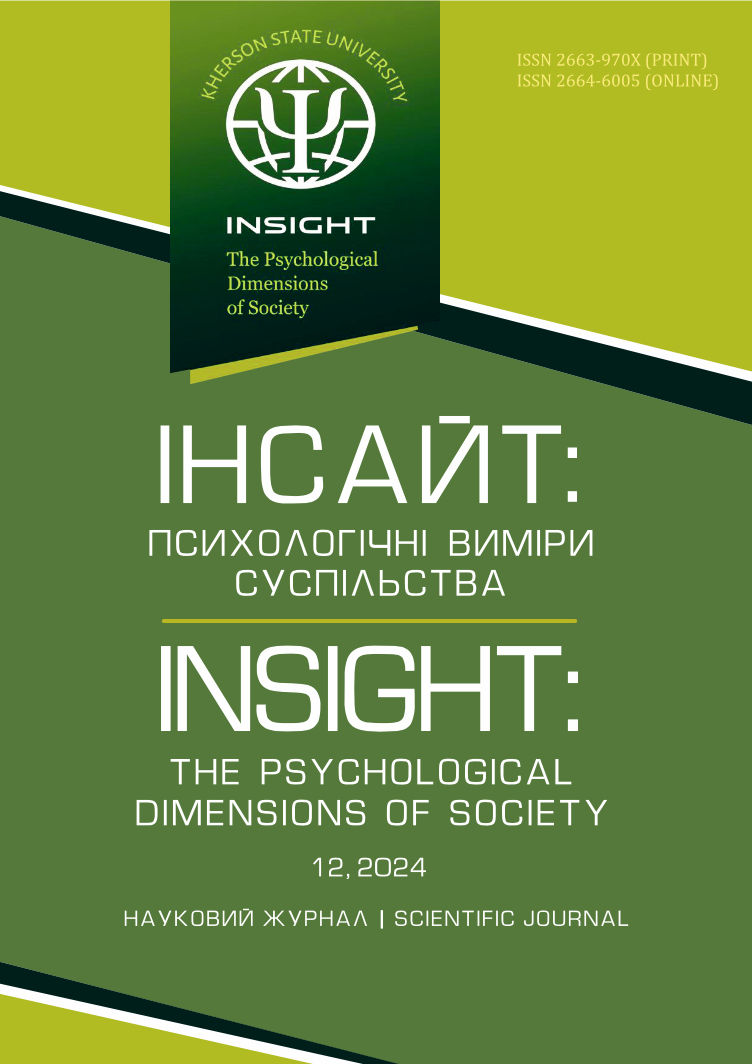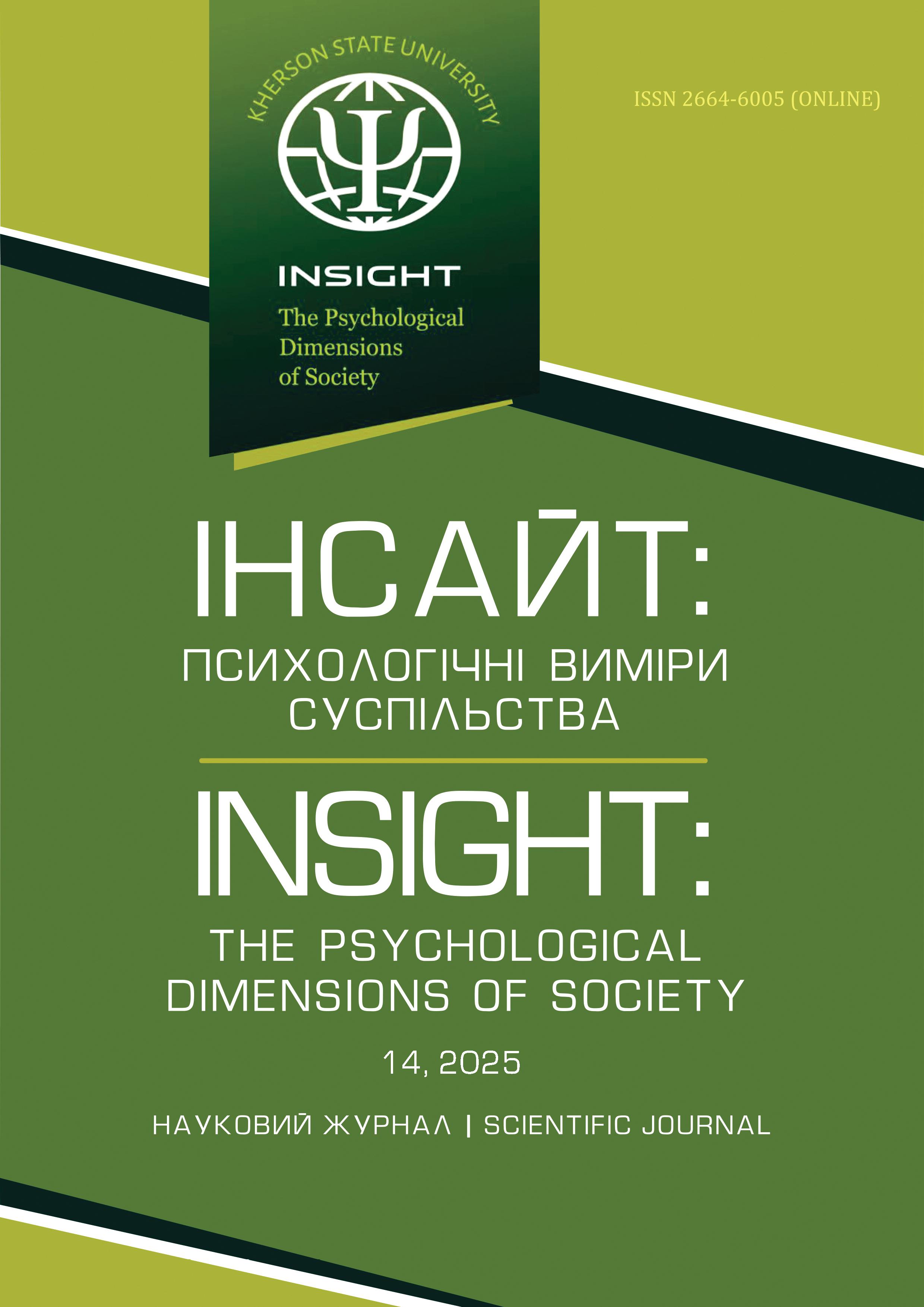Psychological Characteristics of the Body Image of Middle-Aged Women in Organization of Interpersonal Interaction
Abstract
The aim of the research is to identify psychological characteristics of the body image of middle-aged women in organization of interpersonal interaction. Methods. The research involved middle-aged women of 30–43 years (n = 221). The descriptive frequency characteristics of the sample: M = 36.72; SD = ±6.71; Me = 37.00; Mo = 35.00. Valid and reliable questionnaires were used: “The Multidimensional Body-Self Relations Questionnaire” (MBSRQ) (Cash, 2017); “The Body Image Questionnaire” (BIQ) (Skugarevskiy & Sivukha, 2006), “The Body Assessment” (BA) (Harris, 1969). “Fundamental Interpersonal Relationships Orientation–Behavior” (FIRO–B) (Schutz, 1959), “Diagnostics of Interpersonal Relationships” (DIR) (Leary, 1956). Retrospective analysis and generalization of scientific data on the research subject were used. The collected theoretical information and empirical data were substantiated, explained and systematized. Results. It was found that the parameter “average value of satisfaction with body parts” (AVSBP) with the largest number of significant correlations (three) – with authoritarianism (AT), egoism (EG) and aggressiveness (AG) – is the most dependent parameter of the body image in the octant dimensions of the psychogram. The authoritarian type is the most dependent type of interpersonal interaction. It was established that the parameter “average value of satisfaction with body parts” (AVSBP) with the largest number of significant correlations (two) – with inclusion (Iw) and control (Ce) – is the most dependent parameter of the body image in the dimensions of the parameters of interpersonal interaction. Control (Ce) with three inverse significant correlations – with “health status assessment” (HSA), “average value of satisfaction with body parts” (AVSBP) and “average value of concern about overweight” (AVCO) – is the most dependent parameter of interpersonal interaction. Discussion and conclusions. Middle-aged women assess their health status quite highly and demonstrate concern about their appearance. This category of women seldom tries to disguise their weight, mainly having moderate and, to a lesser extent, low satisfaction with their body parts. The vast majority of middle-aged female respondents have an inadequate perception of their body which is a strong argument for dissatisfaction with their body. The hypothesis is confirmed, i.e. the correlation between middle-aged women’s satisfaction with their body and certain indicators of interpersonal interaction was established. The obtained results can be used for conducting more large-scale research on identifying factors of interpersonal interaction in other areas of psychology.
Downloads
References
Altınok A., Kara A. Relationship between body image, psychological symptom level and interpersonal style: Alternative models. Dusunen Adam: The Journal of Psychiatry and Neurological Sciences. 2017. Vol. 30. P. 170–180. https://doi.org/10.5350/DAJPN2017300301
Assaiante C., Barlaam F., Cignetti F., Vaugoyeau M. Body schema building during childhood and adolescence: A neurosensory approach. Clinical Neurophysiology. 2014. Vol. 44(1). P. 3–12. https://doi.org/10.1016/j.neucli.2013.10.125
Bij de Vaate N. A. J. D., Veldhuis J., Konijn E. A. The impact of seeing and posting photos on mental health and body satisfaction: A panel study among Dutch and Japanese adolescents. Computers in Human Behavior. 2023. Vol. 148. P. 107906. https://doi.org/10.1016/j.chb.2023.107906
Blynova O., Popovych I., Hulias I., Radul S., Borozentseva T., Strilets-Babenko O., Minenko O. Psychological safety of the educational space in the structure of motivational orientation of female athletes: a comparative analysis. Journal of Physical Education and Sport. 2022. Vol. 22(11). P. 2723–2732. https://doi.org/10.7752/jpes.2022.11346
Brooks K., Mond J., Stevenson R., Stephen I. Body Image Distortion and Exposure to Extreme Body Types: Contingent Adaptation and Cross Adaptation for Self and Other. Frontiers in Neuroscience. 2016. Vol. 1. https://doi.org/10.3389/fnins.2016.00334
Cash T. F. Multidimensional Body–Self-Relations Questionnaire (MBSRQ). In: Wade, T. (eds) Encyclopedia of Feeding and Eating Disorders. Springer, Singapore. 2017. https://doi.org/10.1007/978-981-287-104-6_3
Cash T. F., Pruzinsky T. Future challenges for body image theory, research, and clinical, practice. In: T. F. Cash & T. Pruzinsky (Eds.), Body images: A handbook of theory, research, and clinical practice (pp. 509–516). New York: Guilford Press, 2002. https://www.sciepub.com/reference/378438
Chen S., van Tilburg W. A. P., Leman P. J. Self-objectification in women predicts approval motivation in online self-presentation. British Journal of Social Psychology. 2022. Vol. 61(1). P. 366–388. https://doi.org/10.1111/bjso.12485
Davison T. E., McCabe M. P. Adolescent body image and psychosocial functioning. Journal of Social Psychology. 2006. Vol. 146(1). P. 15–30. https://doi.org/10.3200/SOCP.146.1.15-30
De Coster L., Sánchez-Herrero P., Lopez-Moreno J., Tajadura-Jiménez A. Use of a real-life practical context changes the relationship between implicit body representations and real body measurements. Scientific Reports. 2021. Vol. 11. https://doi.org/10.1038/s41598-021-93865-7
Emami M., Moghadasin M., Mastour H., Tayebi A. Early maladaptive schema, attachment style, and parenting style in a clinical population with personality disorder and normal individuals: a discriminant analysis model. BMC Psychology. 2024. 12(78). https://doi.org/10.1186/s40359-024-01564-5
Franzoi S., Vasquez K., Sparapani E., Frost K., Martin J., Aebly M. Exploring Body Comparison Tendencies Women Are Self-Critical Whereas Men Are Self-Hopeful. Psychology of Women Quarterly. 2012. Vol. 36. P. 99–109. https://doi.org/10.1177/0361684311427028
Geller J., Srikameswaran S., Zelichowska J. Resilience to shape and weight concerns and disordered eating: the role of self-compassion. Advances in Eating Disorders. 2014. Vol. 3(1). P. 4–12. https://doi.org/10.1080/21662630.2014.945604
Glashouwer K., Bennik E., Jong P., Spruyt A. Implicit Measures of Actual Versus Ideal Body Image: Relations with Self-Reported Body Dissatisfaction and Dieting Behaviors. Cognitive Therapy and Research. 2018. Vol. 42. https://doi.org/10.1007/s10608-018-9917-6
Halian I., Popovych I., Hulias I., Serbin Iy., Vyshnevska O., Kovalchuk Z., Pyslar A. Correlation between personality traits of young athletes and their level of self-efficacy. Journal of Physical Education and Sport. 2023a. Vol. 23(5). P. 1119–1129. https://doi.org/10.7752/jpes.2023.05140
Halian I., Popovych I., Vovk V., Kariyev A., Poleshchuk L., Halian O. Correlation of the coach’s qualities and junior athletes’ self-efficacy. Journal of Physical Education and Sport. 2023b. Vol. 23(7). P 1621–1630. https://doi.org/10.7752/jpes.2023.07199
Harris W. H. Traumatic arthritis of the hip after dislocation and acetabular fractures: treatment of mold arthroplasty. An end-result study using a new method of result evaluation. The Journal of Bone & Joint Surgery. 1969. Vol. 51(4). P. 737–755. https://pubmed.ncbi.nlm.nih.gov/5783851/
He J., Sun S., Zickgraf H., Zhicheng L., Xitao F. Meta-analysis of gender differences in body appreciation. Body Image. 2020. Vol. 30. P. 90–100. https://doi.org/10.1016/j.bodyim.2020.02.011
Грись А., Павлюк О., Гой Н., Лось О. Стратегії самопрезентацій студентської молоді у виборі тенденцій поведінки. Інсайт: психологічні виміри суспільства. 2024. № 11. С. 184–203. https://doi.org/10.32999/2663-970X/2024-11-10
Huang J. S., Norman G. J., Zabinski M. F., Calfas K., Patrick K. Body image and self-esteem among adolescents undergoing an intervention targeting dietary and physical activity behaviors. Journal Adolescent Health. 2007. Vol. 40(3). P. 245–251. https://doi.org/10.1016/j.jadohealth.2006.09.026
Jones D. C., Vigfusdottir T. H., Lee Y. Body Image and the Appearance Culture Among Adolescent Girls and Boys: An Examination of Friend Conversations, Peer Criticism, Appearance Magazines, and the Internalization of Appearance Ideals. Journal of Adolescent Research. 2004. Vol. 19(3). P. 323–339. https://doi.org/10.1177/0743558403258847
Kariyev A., Sultanova Z., Yeraliyeva T., Fadeyeva O., Nazymgul, Assenova N., Nurgalym K. Interactive educational technologies as a factor in the development of the subjectivity of university students. World Journal on Educational Technology: Current Issues. 2022. Vol. 14(3). P. 533–543. https://doi.org/10.18844/wjet.v14i3.7269
Kidd C., Loxton N. J., Uhlmann L. R., Donovan C. L. Motivational processes contributing to disturbances in women’s body image and eating. Eating Behaviors. 2024. Vol. 52. https://doi.org/10.1016/j.eatbeh.2023.101826
Kwon M., Li M., Chang O. D. Examining the roles of dimensions of perfectionism in predicting body image instability: Comparing Asian American and European American women. Current Psychology. 2024. https://doi.org/10.1007/s12144-024-05866-0
Kurova A., Popovych I., Hrys A., Koval I., Pavliuk M., Polishchuk S., Kolly-Shamne A. Dispositional optimistic and pessimistic mental states of young athletes: gender differentiation. Journal of Physical Education and Sport. 2023. Vol. 23(4). P. 857–867. https://doi.org/10.7752/jpes.2023.04110
Leary, T. F. Interpersonal diagnosis of personality a functional theory and methodology for personality evaluation. California: Resource Publications. 1956. 546 pp. URL: https://ia600907.us.archive.org/35/items/interpersonaldia00learrich/interpersonaldia00learrich.pdf
Leung S.‐K. & Bond M. Interpersonal communication and personality: Self and other perspectives. Asian Journal of Social Psychology. 2002. Vol. 4. P. 69–86. https://doi.org/10.1111/1467-839X.00076
Lizana-Calderón P., Alvarado J. M., Cruzat-Mandich C., Díaz-Castrillón F., Quevedo S. Psychometric Properties of the Multidimensional Body-Self Relations Questionnaire-Appearance Scales (MBSRQ-AS) in Chilean Youth. International Journal of Environmental Research and Public Health. 2022. Vol. 20(1). P. 628. https://doi.org/10.3390/ijerph20010628
Murray K., Davey J., Dennis M., Harris D., Hayman E., Rieger E. The effect of appearance and functionality concerns, and weight status, on negative body image mental health literacy in women. Body Image. 2024. Vol. 49. https://doi.org/10.1016/j.bodyim.2024.101703
Nezlek J. Body Image and Day-to-Day Social Interaction. Journal of personality. 1999. Vol. 67. P. 793–817. https://doi.org/10.1111/1467-6494.00073
Nikitina E. S. Psychosemiotic Approach to Comprehension, or a Sense Text Model. International Journal of Language and Linguistics. 2018. Vol. 6(1). P. 15–19. https://doi.org/10.11648/j.ijll.20180601.13
Popovych I., Hudimova A., Bokhonkova Yu., Savchuk O., Hoian I., Shevchenko N. Dispositional Mental States of Internally Displaced University Teachers Under Martial Law: Gender Differences. Journal of Education Culture and Society. 2023a. Vol. 14(2). P. 171–187. https://doi.org/10.15503/jecs2023.2.171.181
Popovych I., Plokhikh V., Hrys A., Pavliuk M., Nosov P., Zinchenko S. Operationalization of footballers’ emotional intelligence in the dimensions of motivational orientation: analysis based on the basic positions. Journal of Physical Education and Sport. 2023b. Vol. 23(3). P. 772–781. https://doi.org/10.7752/jpes.2023.03095
Priyanka P., Tiwari G., Pandey R., Pramod R. The protective strengths of positive body image for somatic symptoms, anxiety, social dysfunction an epression. Hellenic Journal of Psychology. 2022. Vol. 19. P. 21–39. https://doi.org/10.26262/hjp.v19i1.7960
Prokhorenko L., Popovych I., Sokolova H., Chumaieva Yu., Kosenko Yu., Razumovska T., Zasenko V. Gender differentiation of self-regulating mental states of athletes with disabilities: comparative analysis. Journal of Physical Education and Sport. 2023. Vol. 23(2). P. 349–359. https://doi.org/10.7752/jpes.2023.02042
Qureshi D. M. A., Bashir D. M. A., Ghayas S., Ansari D. J. Ideal Body Image and Women’s Psychology: A Systematic Review. KASBIT Business Journal. 2021. Vol. 14(1). P. 23–42. URL: https://www.kasbitoric.com/index.php/kbj/article/view/145
Rogowska A., Nowak P., Kwaśnicka A. Healthy Behavior as a Mediator in the Relationship Between Optimism and Life Satisfaction in Health Sciences Students: A Cross-Sectional Study. Psychology Research and Behavior Management. 2021. Vol. 14. P. 1877–1888. https://doi.org/10.2147/PRBM.S335187
Saffrey C., Bartholomew K., Scharfe E., Henderson A., Koopman R. Self and Partner-Perceptions of Interpersonal Problems and Relationship Functioning. Journal of Social and Personal Relationships. 2003. Vol. 20. P. 117–139. https://doi.org/10.1177/02654075030201006
Schutz W. C. FIRO, A three-dimensional theory of interpersonal behavior. Rinehart & Company, Inc., New York: 1958. 267 pp. Journal of Symbolic Logic. 1959. Vol. 24(3). P. 216–217. https://doi.org/10.2307/2963791
Скугаревский O. A., Сивуха С. В. Образ собственного тела: разработка инструмента для оценки. Психологический журнал. 2006. №2(10). С. 40–48. URL: https://psytests.org
Swami V., Barron D., Tudorel O., Goian C., Vintilă M. Factor Structure and Psychometric Properties of a Romanian Translation of the Body Appreciation Scale-2. Body Image. 2017. Vol. 23. https://doi.org/10.1016/j.bodyim.2017.08.001
Tylka T. Positive Psychology Perspectives on Body Image. Encyclopedia of Body Image and Human Appearance. 2012. Vol. 2. P. 657–663. https://doi.org/10.1016/B978-0-12-384925-0.00104-8
Vargas-Hernández J. G. Kariyev A. D. Didactic Strategies for Meaningful Learning. In R. González-Lezcano (Ed.). Advancing STEM Education and Innovation in a Time of Distance Learning (pp. 47–72). IGI Global. 2023. https://doi.org/10.4018/978-1-6684-5053-6.ch003
Vargas-Hernández J. G., Vargas-González O. C., Castañeda-Burciaga S., Kariyev A. D. Meaningful Learning Didactic Strategies in Higher Education. In: N. Alias, S. Syed-Aris, H. Hashim (Eds.). Cases on Responsive and Responsible Learning in Higher Education (pp. 54–72). IGI Global. 2023. https://doi.org/10.4018/978-1-6684-6076-4.ch004
Voges M., Giabbiconi C.-M., Schöne B., Waldorf M., Hartmann A., Vocks S. Gender Differences in Body Evaluation: Do Men Show More Self-Serving Double Standards Than Women?. Frontiers in Psychology. 2019. Vol. 10. https://doi.org/10.3389/fpsyg.2019.00544
Voges M., Quittkat H., Schöne B., Vocks S. Giving a Body a Different Face – How Men and Women Evaluate Their Own Body vs. That of Others. Frontiers in Psychology. 2022. Vol. 13. P. 853398. https://doi.org/10.3389/fpsyg.2022.853398
Zarate D., Marmara J., Potoczny C., Hosking C., Stavropoulos V. Body Appreciation Scale (BAS-2): measurement invariance across genders and item response theory examination. BMC Psychology. 2021. Vol. 9. P. 114 https://doi.org/10.1186/s40359-021-00609-3
Rodgers R. F., Hewett R. C., Nowicki G. P. A sociocultural model of the relationships between social media use and body image in midlife women. Eating Behaviors. 2024. Vol. 53. https://doi.org/10.1016/j.eatbeh.2024.101867
Zarzhytska O. A. Possibilities of appraisal of social influences on the representation about the body among young girls. Problems of Modern Psychology. 2014. Vol. 26. Р. 212–231. URL: https://journals.uran.ua/index.php/2227-6246/article/view/158809
Zeeni N., Abi Kharma J., Mattar L. Social media use impacts body image and eating behavior in pregnant women. Current Psychology. 2023. Vol. 42. P. 4948–4955. https://doi.org/10.1007/s12144-021-01848-8
Authors who publish with scientific journal agree to the following terms:
• All scientific papers may be freely copied and distributed on any medium and in any format, provided that the references to the initial data of the scientific work are indicated.
• Authors retain copyright and grant the journal right of first publication with the work simultaneously licensed Creative Commons Attribution License .
• Authors are able to enter into separate, additional contractual arrangements for the non- exclusive distribution of the journal’s published version of the work (institutional repository, your website, monograph), with an acknowledgement of its initial publication in this journal.





































